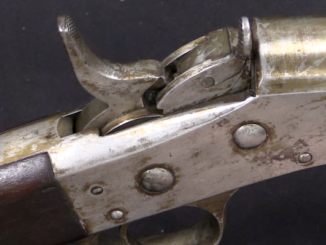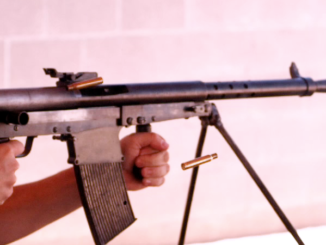In the White: https://www.rockislandauction.com/detail/69/1132
Blued: https://www.rockislandauction.com/detail/69/1133
The 1855 “Root” pocket revolver was a reasonably successful design for the Colt company, although it was not the best mechanical design. The side hammer design used the cylinder axis to rotate and lock in place instead of using the rear face of the cylinder, which resulted in several small and delicate parts. In an effort to correct these deficiencies, Colt and his factory superintendent Elisha Root experimented with a “zig-zag” design as well, which would use and external cam running in grooves on the cylinder wall to rotate and lock it. Root received a patent (#13,999) for a system using a ring trigger and lug on the bottom of the frame, and these two prototype revolvers demonstrate a similar system with the lug on the top of the frame. This system was not ultimately adopted, and these remain just an interesting look into the experimental workings of the Colt company.




As innovative as this design could get, it also reeks of the problems of manufacturing tolerances. One little mistake in machining and your revolver tears itself to pieces just trying to cycle the cylinder! Did I mess up?
As Mauser later showed with their “Zig-Zag” revolver in the 1870s, Remington with the Eliiot-designed “Zig-Zag” pepperbox pocket pistol about the same time, and then various recoil operated revolvers (Webley-Fosbery, Zulaica, Union/Reifgraber, etc.) did at the turn of the 20th Century, this method of cylinder rotation requires extremely good design and machining to work. It’s arguable that the technology of the 1850’s wasn’t quite up to it.
It was also expensive to make if you did it to the tolerances required. I think this might be why Colt ultimately decided against it.
Also, having the cylinder-rotation system on the outside rather than neatly tucked away in back next to the base pin could lead to all sorts of problems due to “environmental” factors such as dirt, mud, etc.
Some historians have suggested that Sam Colt had Root go ahead and patent it mainly to discourage other gunmakers from trying the same system. Even though Colt had no intention of going ahead with it himself. That doesn’t seem to have impeded Remington or Mauser, though.
I think the last small arm designed with this kind of setup was the Pancor “Jackhammer” shotgun/grenade launcher prototype. Or did the Mateba recoil-operated revolver use it, too?
cheers
eon
I think Zig-Zag style and barrel change possibility (see Dan Weeson barrel change) might be used to craft one revolver which can fire multitude of cartridges after change of barrel and cylinder.
–
“cylinder-rotation system on the outside”
I want to notice that also removing metal from cylinder to make steering path mean its weakening, notice that following weapons you mentioned:
“Mauser(…)revolver(…)Remington(…)Zig-Zag(…)Webley-Fosbery(…)Zulaica(…)Union/Reifgraber”
used cartridges of mild pressure (I don’t have data for Mauser revolver) so probably this problem was not serious, but I fear that such cylinder design coupled with high-pressure (Magnum) revolver cartridge might give bad results, or to provide needed safety factor, cylinder of bigger diameter might be necessary.
Other designs also can have some metal removed from cylinder, but mostly it is much smaller amount.
Daweo,
Like Cobray Pocket Pal? ^__^
“Cobray Pocket Pal”
Something like this, but with barrel change possibility rather than multiple barrels fixed. Might be commercially reasonable for places where number of revolver per owner are limited by law AND frame (or trigger-hammer group) is counted as revolver.
Second thought:
must be steering path made from straight lines? or it is optimal solution? how would steering path of shape of Bézier curve influence operation?
The Mauser Model 1878 was made in the standard 10.6 x 24Rmm German Service caliber (same as the Model 1879 and 1883 Reichsrevolvers- the cartridge was developed first), plus in proprietary 6mm and 9mm centerfire rounds in smaller framed versions for commercial sale. All were of course loaded with black powder.
If the 6mm had been a .22 rimfire, it would probably have had more power even with black powder loads. As for the 9mm, it was approximately in the same class as the British 0.380in Eley revolver round used in the original Webley “Bulldog” of the 1870s, and in fact may simply have been a Mauser-made version of that cartridge.
None of them would have generated very high pressures, so they would most likely have been reasonably safe in the Mauser revolvers even with the inherent weakness of the chamber walls.
Although “break-throughs” at the thinnest points might occur with wear, as is often seen on early Colt Open Top metallic-cartridge conversion .44 revolvers on the 1860 Army frame with the original 12-cylinder-stop recess cylinders.
However, very few Mauser revolvers ever saw that much use. Rather like Colt Thuer conversion 1860 Army revolvers, etc.
cheers
eon
I think people get a bit confused about the date when these Zig-Zag Colts were produced because of the dates on their patents. This is because Elisha Root and Samuel Colt both filed “patent caveats” on these designs several years before they pursued full patent status.
Let me give you an outline of the development of these prototypes. BTW, according to factory documentation, all of the zig-zag Colt prototypes, of which there are a few floating around, were all made in 1849 and 1850.
As background, keep in mind that Colt’s original revolver patent was set to expire in 1856, and the company was looking at no longer being a patent protected revolver manufacturer.
In the Autumn of 1849 Elisha K. Root begins development on this Zig-Zag concept. He files a “patent caveat” describing its construction with the U.S. Patent Office on 9 December 1849. (This would eventually be given the U.S. Patent US13999 on 25 December 1855.)
Root is informed in 1850, probably by Colt’s patent lawyers, that there are two previously issued patents that represent the same basic concept. The patent of Otis Whittier US216 of 1837; and the patent of Elijah Jaquith US832 of 1838. Elisha Root purchased these patents from their inventors in 1850 clearing the way for Colt’s sole ownership of the idea.
Samuel Colt had some ideas on how to improve on Root’s design and files his own “patent caveat” on 21 January 1851. (This would later be granted as patent US14905 on 20 May 1856.
On the same date, 21 January 1851, Samuel Colt files a “patent caveat” for the so called “creeping” loading lever. (This is granted patent status on the E. K. Root patent reissue USRE846 of 1 November 1859.)
The Jaquith patent, previously mentioned, where the cuts are made into the back face of the cylinder was also incorporated into a Colt prototype in 1850. (This would later be patented by Samuel Colt as US16683 of 24 February 1857.)
Samuel Colt also patented a center-pin design for the “Root” pistol as US18678; and eventually would patent the as-built design of the so called “Root Revolver” as US20144.
So, what we see in these particular prototypes is: In the brass framed one, this is the Colt improvement of the zig-zag design seen in US14905; And in the blued one, this is an example of the center pin described in US18678 with what looks to be a slight modification on the original Root concept for the cylinder cuts.
My main source for this info: _Samuel Colt: Arms, Art, and Invention_ by Herbert G. Houze, Elizabeth Mankin Kornhauser (Editor), Carolyn C. Cooper (Contribution by). BTW, this book has a very interesting discussion on the back and forth over the Rollin White patent at the Colt’s company; and the flintlock revolver that Colt obtained from the Tower of London. ^__^
One correction, Colt’s 1848 patent extension expired in 1857.